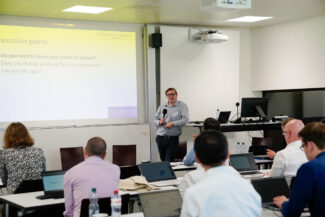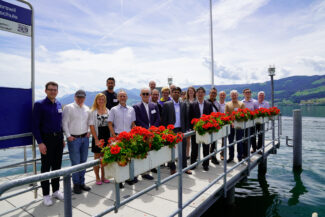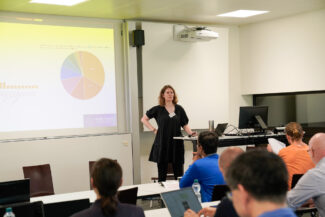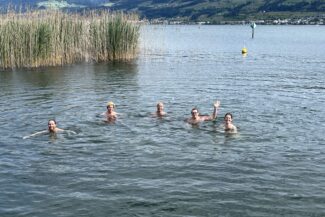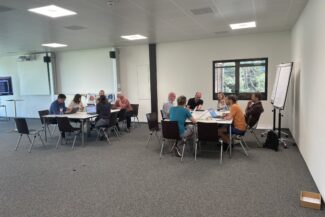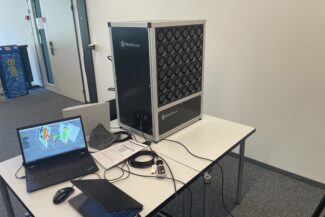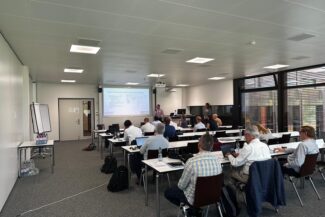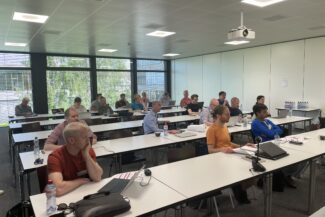Three days of wind energy digitalisation
The IEA Wind TCP is an international co-operation of 24 countries and sponsor members that share information and research activities to advance wind energy deployment. In IEA Wind Task 43, our vision is to unlock the full value of wind energy through digital transformation. Our mission is to act as a digital transformation catalyst by driving open collaboration within and beyond the wind community to deliver insights, recommendations, standards and tools in the key areas of data, culture, and coopetition. Our activities are based on the three “Grand Challenges in the Digitalisation of Wind Energy”, Data, Culture and Coopetition. Read more here.
The IEA Wind Task 43 Annual General Meeting took place from June 17th to June 19th 2024 at the campus of the Eastern Switzerland University of Applied Sciences (OST) in Rapperswil, Switzerland and online. We had about 20 dedicated participants in person from countries including the USA, Brazil, UK, Netherlands, Denmark, Ireland, Sweden, Germany, Austria, Italy and Switzerland, as well as 20-50 online participants from all over the world.
Day 1 – task update day
On the first day, after a welome speech by the vice Head of the Technology School at OST, Frank Ehrig, a short introduction to IEA Wind by Ignacio Marti from DTU Wind (DK), and an overall Task update by our Co-Operating Agent Sarah Barber from OST (CH), we launched into an exciting panel discussion “A roadmap for digital maturity in wind energy“, moderated by our other Co-Operating Agent Shawn Sheng from NREL (USA). The speakers were Tom Clark from Octue (UK), Dimitrios Kyritsis from the University of Oslo (NO), Rupp Carriveau from the University of Windsor (CA) and Raja Pulikollu from EPRI (USA).
This was followed by three one-hour presentations and workshops about our four working groups: WG1 (Data), WG2&3 (Culture and Coopetition) and WG4 (Use Case Demonstrations). This then allowed us to think about the opportunities of overlaps between Working Groups and define actions to exploit these opportunities. We finished off the day with a quick dip in the lake.
Some findings and suggestions from the day include:
- Focus on relationships and trust with small groups – others will follow.
- Wind energy needs digital passports.
- We should get involved with „energy data space“ projects and funding programmes.
- „Use cases“ should start small in order to demonstrate value with low effort.
- The challenges of digitalisation are very interlinked, so we need to ensure and improve communication between different parties as much as possible.
- There seems to be a large potential for collaboration with other IEA Wind Tasks, so we should make an effort to connect with each other.
- Start with „frictionless data access“ and the rest will come.
Day 2 – digital skills day
On the second day, we jumped straight in with a panel discussion “What are digital skills and why are they important for the wind energy sector?” with Nikolay Dimitrov from DTU Wind (DK), Helena Solman from the University of Wageningen (NL), Lisa Kortmann from OST (CH), Mariana Batista from WindEurope (BE) and Clara Wrede from Digital Switzerland (CH). We then held three “skills and demo workshops” on the topics of “culture, collaboration, communication and diversity”, followed by “JSON schema and data services”, and finally on “ontologies and knowledge graphs”. These workshops involved a combination of presentations, live demonstrations, and small group work. At the end, we discussed the DigiWind Skills Survey and finished by concluding how digital skills overlap with the goals of IEA Wind Task 43.
Some findings and suggestions from the day include:
- Digital skills are an inherent part of digital culture, and should be made available by organisations.
- As well as diverse technical skills, digital skills also encompass softer skills such as communication, collaboration, and diversity & inclusion.
- One of the main challenges we identified was bridging the gap between domain experts and digital experts. Should one person try to obtain all these skills? Should multiple people from different disciplines work together in teams? How can such teams be successfully managed?
- We identified the sheer amount of data being generated by wind turbines as very unique, and a big opportunity for us to exploit this and make the sector more attractive to work in.
- We at IEA Wind Task 43 are looking forward to defining our exact role in fostering digitalisation through digital skills in the near future!
If you want to contribute to Task 43 now, please take five minutes to complete our Culture Questionnaire!
Day 3 – WeDoWind day
The third day was dedicated to WeDoWind, a framework developed by OST for bringing asset owners together with researchers and model developers in a “win-win” situation, whereby asset owners get easy access to state-of-the-art data analytics and model developers get access to relevant asset data to train and validate their models. After an introduction to WeDoWind from Sarah Barber, she moderated a panel discussion “Data-related challenges and opportunities in wind farm operations” with Charlie Plumley from Glenmont Partners (UK), Lewis Armistead from Apex Clean Energy (USA), Phil Bradstock from Bitbloom (UK), Christian Jonsson from KUDO Software (UK), and Agota Greičiūnienė from Ignitis (LT).
After a short “working with WeDoWind” workshop, Lewis Armistead announced a new WeDoWind Challenge: FAIR Schemas for Wind Turbine SCADA Data. The goal of this challenge is to co-develop FAIR (Findable, Accessible, Interoperable, Reusable) open-source semantics for wind turbine SCADA (meta)data with Apex that we can centrally maintain and instantiate within our various digital systems, namely as User-Defined Types (UDTs) in our SCADA software and as dimensional tables within our SQL data warehouse service. Find out more and sign up for the challenge here.
In the afternoon, we ran three parallel challenge-solving workshops:
1. The Apex Clean Energy FAIR Information Model for Wind Turbine SCADA Data (Lewis Armistead)
2. The ODE Yaw Misalignment Challenge (Charlie Plumley). Read more here.
3. Expanding WeDoWind to a holistic open innovation wind energy ecosystem (Sarah Barber)
Some findings and suggestions from the day include:
- WeDoWind needs promoting more!
- We need more in-person events.
- We need more data engineers in IEA Wind Task 43.
- Scaling WeDoWind and making it sustainable in the long-term is going to be hard.
- SCADA data is heterogeneous and can tell us everything or nothing, depending on how carefully we carry out our analyses.
- We should find problems of limited scope to collaborate on and address one at a time.
Find out more about WeDoWind here.
Final word
We all enjoyed the hard work, nice weather, and cool lake in Rapperswil at the OST campus over the three days of the event. We are looking forward to more nice collaborations on the digitalisation of wind energy as part of IEA Wind Task 43 and beyond! Thanks to all the motivated contributors, speakers and swimmers! Some quotes from participants:
One of the best events I have ever attended!
I loved the enthusiasm and knowledge of the attendees.
Thanks for the engaging discussions and interactive content!
An inspiring project and a well-organised event!
Joining IEA Wind Task 43
Please feel free to join us in fostering digitalisation in the wind energy sector in whatever capacity you can. You can join our Working Group monthly meetings, get active in sub-Working Groups, apply to be on the Organising Committee, or advise us in the Industrial Advisory Board!
Regardless of which country you are based in, you can join us using this form. You will then receive further information about what to do. We try to find pragmatic solutions to allow contributions from a wide range of people from different countries. Please don’t hesitate to fill out the form!
